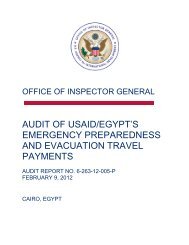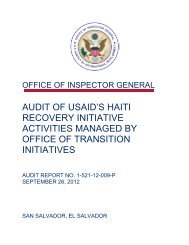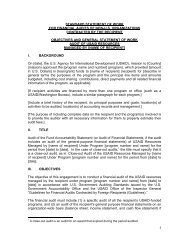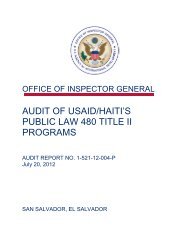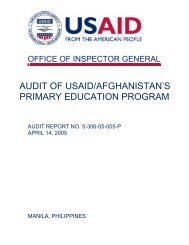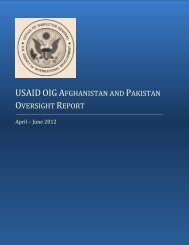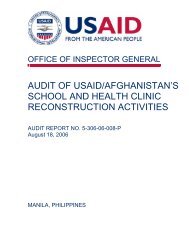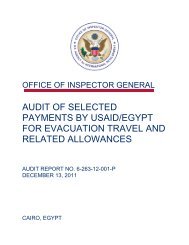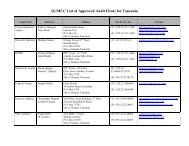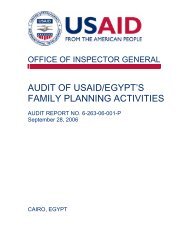Audit of USAID/Egypt's Agricultural Exports and Rural Incomes Project
Audit of USAID/Egypt's Agricultural Exports and Rural Incomes Project
Audit of USAID/Egypt's Agricultural Exports and Rural Incomes Project
You also want an ePaper? Increase the reach of your titles
YUMPU automatically turns print PDFs into web optimized ePapers that Google loves.
OFFICE OF INSPECTOR GENERALAUDIT OF <strong>USAID</strong>/EGYPT’SAGRICULTURAL EXPORTSAND RURAL INCOMESPROJECTAUDIT REPORT NO. 6-263-07-001-PFebruary 21, 2007CAIRO, EGYPT
Office <strong>of</strong> Inspector GeneralFebruary 21, 2007MEMORANDUMTO:FROM:SUBJECT:<strong>USAID</strong>/Egypt Director, Kenneth C. EllisRegional Inspector General/Cairo, David H. Pritchard /s/<strong>Audit</strong> <strong>of</strong> <strong>USAID</strong>/Egypt’s <strong>Agricultural</strong> <strong>Exports</strong> <strong>and</strong> <strong>Rural</strong> <strong>Incomes</strong> <strong>Project</strong>(Report No. 6-263-07-001-P)This is our report on the subject audit. The report includes five recommendations to (1)redesign a section <strong>of</strong> the project, (2) enforce the requirement that project’s grantees submitprogress reports that address expected results, (3) analyze the quarterly reports, (4) testsupport for results reported by the grantees, <strong>and</strong> (5) correct the Performance Monitoring Plan.In finalizing this report, we considered your comments to our draft report <strong>and</strong> have includedthem as Appendix II. Based on these comments, we concur that management decisions havebeen made on all five recommendations, <strong>and</strong> that final action on these recommendations ispending. Please coordinate final action with <strong>USAID</strong>’s <strong>Audit</strong>, Performance <strong>and</strong> ComplianceDivision.I appreciate the cooperation <strong>and</strong> courtesy extended to my staff during the audit.U.S. Agency for International DevelopmentRegional Inspector General/CairoUnit 64902, APO, AE 09839-4902
CONTENTSSummary <strong>of</strong> Results ....................................................................................................... 1Background ..................................................................................................................... 2<strong>Audit</strong> Objectives ................................................................................................................ 2<strong>Audit</strong> Findings................................................................................................................. 3Has <strong>USAID</strong>/Egypt’s investment in the <strong>Agricultural</strong> <strong>Exports</strong><strong>and</strong> <strong>Rural</strong> <strong>Incomes</strong> <strong>Project</strong> increased the number <strong>of</strong> jobsfor project participants as planned? .................................................................................. 3<strong>USAID</strong>/Egypt Needed to EstablishBetter Targets <strong>and</strong> Methods forMeasuring <strong>Project</strong> Progress........................................................................................ 3<strong>USAID</strong>/Egypt Needed to ImproveOversight <strong>of</strong> Grantee Reporting .................................................................................. 6<strong>USAID</strong>/Egypt Needed to Better VerifyReported Results ........................................................................................................ 8<strong>USAID</strong>/Egypt Needed to Correct ItsPerformance Monitoring Plan.................................................................................... 10Has <strong>USAID</strong>/Egypt’s investment in the <strong>Agricultural</strong> <strong>Exports</strong><strong>and</strong> <strong>Rural</strong> <strong>Incomes</strong> <strong>Project</strong> increased the rural householdincomes <strong>of</strong> project participants as planned? ................................................................... 12Grantees Needed to Better SupportReported Results ...................................................................................................... 12Evaluation <strong>of</strong> Management Comments ....................................................................... 14Appendix I – Scope <strong>and</strong> Methodology ........................................................................ 16Appendix II – Management Comments ....................................................................... 19Appendix III – Technical Appendix for Jobs Calculations ........................................ 24Appendix IV – Technical Appendix for Income Calculations.................................... 29
SUMMARY OF RESULTSThe <strong>Agricultural</strong> <strong>Exports</strong> <strong>and</strong> <strong>Rural</strong> <strong>Incomes</strong> <strong>Project</strong> was a 4-year, $57.3 million <strong>USAID</strong>project that began in the last quarter <strong>of</strong> 2003 as one <strong>of</strong> several activities within<strong>USAID</strong>/Egypt’s strategic objective for strengthening the environment for trade <strong>and</strong>investment. The project’s overall expected results were to increase on-farm <strong>and</strong>agribusiness jobs <strong>and</strong> rural incomes. The project expended $17.0 million throughSeptember 30, 2005. The objectives <strong>of</strong> the audit were to determine if the project hasincreased jobs <strong>and</strong> rural household incomes <strong>of</strong> project participants as planned. (Seepage 2.)For the activities audited, the project has not increased jobs <strong>of</strong> its participants asplanned, <strong>and</strong> the grantees were unable to support the income results they reported. Inaddition, <strong>USAID</strong>/Egypt needed to strengthen controls associated with monitoring <strong>and</strong>reporting on the project. (See pages 3, 6, 8, 10, <strong>and</strong> 12.)This report includes five recommendations to the <strong>USAID</strong>/Egypt Director to (1) redesign asection <strong>of</strong> the project, (2) enforce the requirement that the project’s grantees submitprogress reports that address expected results, (3) analyze the quarterly reports, (4) testsupport for results reported by grantees, <strong>and</strong> (5) correct the Performance MonitoringPlan. (See pages 6, 8, 10, <strong>and</strong> 11.)Appendix II contains management comments in their entirety. In its comments,<strong>USAID</strong>/Egypt generally agreed with the findings <strong>and</strong> reported that managementdecisions had been reached on all five audit recommendations. Among other things, forexample, the Mission agreed that the project was not designed to increase jobs, <strong>and</strong> theMission planned to drop the jobs indicators used for measuring project progress. Weconcur that management decisions have been reached. (See pages 19-23.)1
BACKGROUNDThe <strong>Agricultural</strong> <strong>Exports</strong> <strong>and</strong> <strong>Rural</strong> <strong>Incomes</strong> <strong>Project</strong> was a 4-year, $57.3 million <strong>USAID</strong>project that began in the last quarter <strong>of</strong> 2003 as one <strong>of</strong> several activities within<strong>USAID</strong>/Egypt’s strategic objective for strengthening the environment for trade <strong>and</strong>investment. A significant purpose <strong>of</strong> this project was to strengthen the competitiveness<strong>of</strong> Egypt’s agriculture, <strong>and</strong> the project’s overall expected results were to increaseon-farm <strong>and</strong> agribusiness jobs <strong>and</strong> rural incomes. The project expended $17.0 millionthrough September 30, 2005, which represents its first 2 years.<strong>USAID</strong>/Egypt awarded two contracts, one cooperative agreement, <strong>and</strong> two grants forfive project components designed to provide technical assistance, training <strong>and</strong>commodities through: (1) grants to support infrastructure <strong>and</strong> equipment needs <strong>of</strong> smallfarmers; (2) support to Egyptian agricultural trade associations; (3) support tosmallholders; (4) support for international linkages between Egyptian <strong>and</strong> Americanscientists; <strong>and</strong> (5) technical assistance for the design <strong>of</strong> a legacy program to ensure thesustainability <strong>of</strong> achievements attained under the project.With respect to the component to support smallholders, which was the primary focus <strong>of</strong>this audit due to this component being the only component that had specific linkages tothe expected project results <strong>of</strong> increasing on-farm <strong>and</strong> agribusiness jobs <strong>and</strong> ruralincomes, <strong>USAID</strong>/Egypt signed a grant agreement with ACDI/VOCA on October 1, 2003,for $7.9 million to work with dairy <strong>and</strong> livestock farmers. The second grantee wasCARE, with which <strong>USAID</strong> signed a grant agreement on September 21, 2003, for $10.9million to work with horticulture farmers.AUDIT OBJECTIVESWe conducted this audit as part <strong>of</strong> the Office <strong>of</strong> Inspector General’s audit plan for fiscalyear 2006 to answer the following questions:• Has <strong>USAID</strong>/Egypt’s investment in the <strong>Agricultural</strong> <strong>Exports</strong> <strong>and</strong> <strong>Rural</strong> <strong>Incomes</strong> <strong>Project</strong>increased the number <strong>of</strong> jobs for project participants as planned?• Has <strong>USAID</strong>/Egypt’s investment in the <strong>Agricultural</strong> <strong>Exports</strong> <strong>and</strong> <strong>Rural</strong> <strong>Incomes</strong> <strong>Project</strong>increased the rural household incomes <strong>of</strong> project participants as planned?Appendix I contains a discussion <strong>of</strong> the audit's scope <strong>and</strong> methodology.2
AUDIT FINDINGSHas <strong>USAID</strong>/Egypt’s investment in the <strong>Agricultural</strong> <strong>Exports</strong> <strong>and</strong><strong>Rural</strong> <strong>Incomes</strong> <strong>Project</strong> increased the number <strong>of</strong> jobs for projectparticipants as planned?For the activities audited, <strong>USAID</strong>/Egypt’s investment in the Agriculture Export <strong>and</strong> <strong>Rural</strong><strong>Incomes</strong> <strong>Project</strong> has not increased the number <strong>of</strong> jobs as planned. Factors thatimpaired progress included:• The grantees had not met the planned annual targets for increasing jobs.• The grantees had not adequately reported their progress in meeting the annualtargets for increasing jobs.• The grantees could not provide support for all reported results.• <strong>USAID</strong>/Egypt’s Performance Monitoring Plan reported inaccurate information on theincreases in the number <strong>of</strong> jobs.As discussed in the following sections, <strong>USAID</strong>/Egypt needed to (1) establish bettertargets <strong>and</strong> methods for measuring project progress, (2) improve oversight <strong>of</strong> granteereporting, (3) better verify reported results, <strong>and</strong> (4) correct its Performance MonitoringPlan.<strong>USAID</strong>/Egypt Needed to EstablishBetter Targets <strong>and</strong> Methods forMeasuring <strong>Project</strong> ProgressSummary: According to the grant agreements, ACDI/VOCA <strong>and</strong> CARE were toincrease jobs by 5,787 <strong>and</strong> 12,667, respectively, over the first 2 years <strong>of</strong> the project.Neither grantee has met their annual planned targets. This occurred because <strong>of</strong> aproblematic project design, a shift in the focus <strong>of</strong> the activities, <strong>and</strong> the grantees’ use<strong>of</strong> unreliable methodologies to measure increases in jobs. As a result, the project asrelated to increasing jobs has not been effective.ACDI/VOCA – The grant agreement indicated that ACDI/VOCA would generate2,390 new jobs in the first year <strong>and</strong> 3,397 in the second year, for a 2-year total <strong>of</strong> 5,787new on-farm jobs.ACDI/VOCA did not meet either <strong>of</strong> these targets. Although ACDI/VOCA did not reporton results for the first-year target, the Chief <strong>of</strong> Party said that ACDI/VOCA did not meetit. ACDI/VOCA did produce a performance report dated September 2005, whichincluded results for the first 2 years <strong>of</strong> the project. This report said that ACDI/VOCAincreased jobs by 4,594, or 79 percent <strong>of</strong> the 2-year target. However, as discussed laterin this report, ACDI/VOCA used an unreliable methodology to calculate these increases,resulting in an overstatement <strong>of</strong> accomplishments. For example, ACDI/VOCA’smethodology included the calculation <strong>of</strong> amounts based on indirect farmers, whereas<strong>USAID</strong> approved the project based on the intended results for direct beneficiaries. The3
amounts attributed to indirect farmers represented approximately 84 percent <strong>of</strong> thereported results.Both a <strong>USAID</strong>/Egypt <strong>of</strong>ficial <strong>and</strong> an ACDI/VOCA <strong>of</strong>ficial stated that working with dairy<strong>and</strong> livestock farmers would not increase jobs as previously believed.CARE – The grant agreement contained annual targets <strong>of</strong> increasing jobs by 6,000 inthe first year <strong>and</strong> 6,667 in the second year, for a 2-year total <strong>of</strong> 12,667 new, on-farmjobs.CARE did not meet these targets. According to performance reports provided by CARE,CARE increased jobs in the first 2 years by 6,412, or 50.6 percent <strong>of</strong> its target.However, as discussed later in this report, CARE used an unreliable methodology tocalculate these increases, resulting in an overstatement <strong>of</strong> accomplishments.CARE has submitted a request to <strong>USAID</strong>/Egypt to reduce its portion <strong>of</strong> the project’soverall results from a 4-year total <strong>of</strong> 40,000 jobs to 13,333—one third <strong>of</strong> the originaltarget. CARE said that the 40,000 target was “completely unrealistic”.ACDI/VOCA <strong>and</strong> CARE have not achieved the targets for increasing jobs because <strong>of</strong> (1) aproblematic project design, (2) a shift in the focus <strong>of</strong> the activities, <strong>and</strong> (3) the grantees’ use<strong>of</strong> unreliable methodologies to measure increases in jobs.<strong>Project</strong> Design — According to economists within <strong>USAID</strong>/Egypt, measuring a project’simpact on job creation involves the use <strong>of</strong> extensive surveys <strong>and</strong>/or complicatedextrapolations using proxy indicators. As the approval documents went throughadaptations for the project agreement, Request for Proposals/Applications, <strong>and</strong> grantstages, the creation <strong>of</strong> jobs was elevated to a primary indicator. This was particularlyproblematic because job creation occurs later in a project’s life, sometimes years after aproject concludes. In hindsight, Mission <strong>of</strong>ficials concluded that jobs creation should nothave been elevated to an indicator. The Chiefs <strong>of</strong> Party for both grantees stated that theannual targets were “overly ambitious.”Shift in Focus — ACDI/VOCA <strong>and</strong> CARE shifted their focus. After <strong>USAID</strong>/Egypt signedrespective grant agreements with ACDI/VOCA <strong>and</strong> CARE, <strong>USAID</strong>/Egypt changed oneaspect <strong>of</strong> the overall project as a result <strong>of</strong> a visit from an Under Secretary for theDepartment <strong>of</strong> State. The Mission substituted a grant activity for the original policyactivity. This grant activity was to supply small farmers’ associations with neededequipment or facilities to improve the quality <strong>of</strong> products as well as to increase farmingefficiency. This change affected both grantees because <strong>USAID</strong>/Egypt expected thegrantees to facilitate the formation <strong>of</strong> these small farmers’ associations <strong>and</strong> then get theassociations ready to submit grant proposals. ACDI/VOCA <strong>and</strong> CARE stated that theyspent most <strong>of</strong> their effort in institution building to prepare the farmers to accept thegrants.This additional work was not included in either grant agreement. <strong>USAID</strong>/Egypt amendedthe grant agreement with ACDI/VOCA on June 28, 2005, by increasing the awardamount by approximately $380,000 to pay for additional work. However, <strong>USAID</strong>/Egyptdid not amend the scope <strong>of</strong> work to specify the additional work or change any <strong>of</strong> theoriginal jobs targets. <strong>USAID</strong>/Egypt did not amend CARE’s grant agreement.4
Methodologies to Measure Increases in Jobs — ACDI/VOCA <strong>and</strong> CARE usedunreliable methodologies to calculate the increases in the number <strong>of</strong> jobs.ACDI/VOCA based its results on a complex formula applied to data extracted from asurvey, but the methodology was not fully accurate <strong>and</strong> valid. (See Appendix III fordetails.). Examples include the following:• ACDI/VOCA was unable to provide documentation to support an assumption thatevery increase <strong>of</strong> 10 animals would create three jobs for dairy farmers. Additionally,as previously stated, a <strong>USAID</strong> <strong>of</strong>ficial <strong>and</strong> an ACDI/VOCA <strong>of</strong>ficial both stated thatACDI/VOCA’s activities would not increase jobs (See Appendix III, page 24).• ACDI/VOCA was unable to support the attribution <strong>of</strong> its activities to the animals thatwere born. When calculating the increase in animals, ACDI/VOCA included thefemale animals that were born to the baseline animals <strong>and</strong> that matured during theyear. However, these animals were born prior to the project’s commencement.Accordingly, ACDI/VOCA should not have added to the baseline those that wereborn <strong>and</strong> matured before the project started (See Appendix III, page 26).• ACDI/VOCA’s methodology included the calculation <strong>of</strong> amounts based on indirectfarmers, whereas <strong>USAID</strong> approved the project based on the intended results fordirect beneficiaries. The amounts attributed to indirect farmers representedapproximately 84 percent <strong>of</strong> the reported results. Indirect farmers refer to thosefarmers who did not participate directly in the activities, but learned about the newtechnology through other direct farmers. According to several project documents,including the Activity Approval Document, the Request for Applications, <strong>and</strong> thePerformance Monitoring Plan, ACDI/VOCA should have measured the jobs impacton direct beneficiaries—not on indirect ones. However, the grant agreementincluded ambiguous language regarding the inclusion <strong>of</strong> indirect farmers’ results,causing confusion among <strong>USAID</strong> <strong>of</strong>ficials about what they should expect as results.According to one <strong>USAID</strong> <strong>of</strong>ficial, <strong>USAID</strong>/Egypt should receive results for just thedirect beneficiaries because it is very difficult to get an accurate <strong>and</strong> agreed-uponnumber for indirect results (See Appendix III, pages 24-25).CARE’s methodology for calculating results was also not fully supported or accurate(See Appendix III for details.). Examples include the following:• CARE did not have support for an assumption that one new on-farm job was createdfor every feddan 1 that farmers switched from lower-value field crops (such as wheator berseem) to high-value horticulture (such as green beans or cantaloupes).According to CARE's Chief <strong>of</strong> Party, this formula came from a previous <strong>USAID</strong>project called Agriculture-Led Export Businesses. However, as explained in a report<strong>of</strong> that project that discussed the “Input-Output Model,” this formula was applicable toa new input—not a switch in inputs, which in this case is a switch in crops (SeeAppendix III, page 27).• When calculating the new jobs, CARE did not take into account the jobs that existedon the l<strong>and</strong> prior to switching to high-value crops. CARE stated that its farmers grew2,972 feddans <strong>of</strong> high-value horticulture. Assuming one new job for every feddan <strong>of</strong>1 In Egypt, a feddan is a unit <strong>of</strong> l<strong>and</strong> area equal to about 1.038 acres.5
high-value horticulture, CARE reported that it created 2,972 jobs. However, CAREdid not take into account that the l<strong>and</strong> previously grew a different crop that requiredlabor (See Appendix III, pages 27-28).• When calculating the 2,972 feddans that produced high-value horticulture, CARE didnot exclude the portion <strong>of</strong> these 2,972 feddans that was already producinghigh-value horticulture prior to CARE’s activities. For example, an independentsurvey that CARE commissioned during the project stated that approximately 25percent <strong>of</strong> farms in Upper Egypt already grew high-value horticulture (SeeAppendix III, page 27).As a result <strong>of</strong> the problematic project design, the shift in the focus <strong>of</strong> the project’s activities,<strong>and</strong> the use <strong>of</strong> unreliable methodologies to measure increases in jobs, the project asrelated to increasing jobs has not met established targets. In discussing this issue with<strong>USAID</strong>/Egypt <strong>of</strong>ficials, they mentioned that the project has provided many benefits thatwere beyond the scope <strong>of</strong> our audit, <strong>and</strong> they emphasized the project’s importance toEgypt. They agreed that the creation <strong>of</strong> jobs was not a good indicator.To address the design issue <strong>and</strong> the change in focus for some project activities,including the difficulty <strong>of</strong> trying to measure increases in jobs, we make the followingrecommendation:Recommendation No. 1: We recommend that the <strong>USAID</strong>/Egypt Directorredesign the jobs section <strong>of</strong> the <strong>Agricultural</strong> <strong>Exports</strong> <strong>and</strong> <strong>Rural</strong> <strong>Incomes</strong> <strong>Project</strong> toestablish appropriate indicators <strong>and</strong> targets for measuring project progress.<strong>USAID</strong>/Egypt Needed to ImproveOversight <strong>of</strong> Grantee ReportingSummary: Both grant agreements required each grantee to submit quarterlyreports to <strong>USAID</strong>/Egypt regarding the progress towards grantees’ goals. However,the grantees had not adequately met the reporting requirements due to insufficient<strong>USAID</strong>/Egypt oversight. As a result, <strong>USAID</strong>/Egypt was not able to determine if theproject was effective.Both grant agreements included a reporting requirement that stated that the grantee willsubmit quarterly reports, due within 30 days after the reporting period, which “willcontain: a comparison <strong>of</strong> actual accomplishments with the goals, objectives, <strong>and</strong>milestones established for the period; reasons why established goals were (or are not)being met; <strong>and</strong> other pertinent information.” Also within their grant agreements, each <strong>of</strong>the grantees had established annual goals that <strong>USAID</strong>/Egypt expected them to meet.ACDI/VOCA <strong>and</strong> CARE did not meet this reporting requirement. Although ACDI/VOCAsubmitted quarterly reports, the reports did not address results, including a comparison<strong>of</strong> actual accomplishments to the annual targets for jobs.6
To address the grantees’ noncompliance with reporting requirements <strong>and</strong> the need forcloser oversight <strong>of</strong> the reporting, we make the following recommendations:Recommendation No. 2: We recommend that the <strong>USAID</strong>/Egypt Director enforcethe requirement that grantees under the <strong>Agricultural</strong> <strong>Exports</strong> <strong>and</strong> <strong>Rural</strong> <strong>Incomes</strong><strong>Project</strong> submit progress reports that address each <strong>of</strong> their expected results intheir grant agreements, including reasons for meeting or not meeting theexpected results.Recommendation No. 3: We recommend that the <strong>USAID</strong>/Egypt Director requirethe appropriate Mission personnel to analyze the quarterly reports under the<strong>Agricultural</strong> <strong>Exports</strong> <strong>and</strong> <strong>Rural</strong> <strong>Incomes</strong> <strong>Project</strong>, including comparing the reportedresults to planned results specified in documentation such as the grantagreements.<strong>USAID</strong>/Egypt Needed toBetter Verify Reported ResultsSummary: Contrary to the St<strong>and</strong>ards for Internal Control in the FederalGovernment, the grantees did not maintain readily available documentation tosupport their reported results. <strong>USAID</strong>/Egypt’s oversight <strong>of</strong> reported results was notsufficient to identify these internal control weaknesses. As a result, <strong>USAID</strong>/Egyptdid not have sufficient assurance that information grantees reported was reliable.The Government Accountability Office’s St<strong>and</strong>ards for Internal Control in the FederalGovernment states that internal controls <strong>and</strong> all transactions <strong>and</strong> other significant eventsneed to be clearly documented <strong>and</strong> that such documentation should be readily availablefor examination.Each grantee had a separate process for collecting, recording, summarizing, <strong>and</strong>reporting data, but those processes did not ensure the reliability <strong>of</strong> the reported data.ACDI/VOCA – ACDI/VOCA employed the following process to collect, record,summarize, <strong>and</strong> report results to <strong>USAID</strong>/Egypt:1. A monitoring <strong>and</strong> evaluation team from ACDI/VOCA headquarters in Cairo designeda two-page survey to give farmers to determine the impact <strong>of</strong> the project’s activities.2. The team determined sample size, locations to visit, <strong>and</strong> target groups to interview.3. The team visited the sample <strong>of</strong> 179 beneficiary farmers in Upper Egypt to surveythem on several points, such as how much milk the farmers’ animals produced <strong>and</strong>for the price they sold the milk.4. The team filled out the two-page survey forms based on the farmers’ responses.5. The team tabulated <strong>and</strong> summarized the survey responses in a spreadsheetgrouped by governorate <strong>and</strong> village.6. The team then entered the baseline data into the spreadsheet as a basis forcomparison.7. The team designed formulas within the spreadsheet using the farmers’ responses<strong>and</strong> other information, such as baseline data, to calculate the results.8
8. The team surveyed a sample <strong>of</strong> three indirect farmers on the impact <strong>of</strong> projectactivities on their production.9. ACDI/VOCA wrote the “First Year Impact Report – September 2005” usingsummarized information from the spreadsheet.10. ACDI/VOCA submitted the “First Year Impact Report” to <strong>USAID</strong>/Egypt.ACDI/VOCA’s process for collecting, recording, summarizing, <strong>and</strong> reporting data lackedreliability for several reasons. For instance, ACDI/VOCA based its reported results onsurveys performed <strong>of</strong> 179 farmers in Upper Egypt, but Mission <strong>of</strong>ficials stated that thefarmers were reluctant to share farming information. Moreover, according to Mission<strong>of</strong>ficials, the farmers may not have understood many <strong>of</strong> the survey questions. Therefore,it was difficult to determine the reliability <strong>of</strong> the results collected. In addition,ACDI/VOCA summarized the information from the surveys <strong>and</strong> used the results in manycomplex formulas, which were subject to error. (See Appendices III <strong>and</strong> IV for details.)Also, ACDI/VOCA was unable to provide support for reported results due to weaknessesin control processes that affected the collection, recording, summarizing, <strong>and</strong> reporting<strong>of</strong> results to <strong>USAID</strong>/Egypt. ACDI/VOCA surveyed 179 <strong>of</strong> 1,973 beneficiary farmers tocalculate their results. Based on our review <strong>of</strong> half <strong>of</strong> the farmers in one governorate <strong>of</strong>Egypt, we could not verify 24 <strong>of</strong> 24 sampled surveys. For instance, many <strong>of</strong> theamounts reported by the farmers on the survey (such as what price they sold milk for orhow much milk they produced) were significantly different from the amounts they told us.In addition, ACDI/VOCA was unable to provide the formulas they used to tabulate <strong>and</strong>summarize the results as well as support the baseline data they used in thespreadsheet. As a result, we were unable to validate the results ACDI/VOCA reported to<strong>USAID</strong>/Egypt.CARE – CARE employed the following process to collect, record, summarize, <strong>and</strong> reportresults to <strong>USAID</strong>/Egypt:1. Each CARE field <strong>of</strong>fice’s marketing specialist either visited or called the farmers’associations approximately every two weeks.2. Marketing specialists filled out the data collection forms based on the farmers’associations’ information.3. A data input specialist in each field <strong>of</strong>fice inputed the information from the datacollection forms into the computer database.4. The regional <strong>of</strong>fice area manager in each field <strong>of</strong>fice reviewed the databaseinformation to ensure that there were no errors <strong>and</strong> that the information made sense.5. A data input specialist then submitted the database information to the headquarters<strong>of</strong>fice in Cairo.6. The Headquarters <strong>of</strong>fice combined each field <strong>of</strong>fice’s information.7. The Headquarters <strong>of</strong>fice prepared quarterly reports based on the summarizedinformation in the database.8. CARE’s headquarters <strong>of</strong>fice sent <strong>USAID</strong>/Egypt quarterly reports based on thissummarized database information.CARE was unable to provide documentation to support the results that it reported to<strong>USAID</strong>/Egypt for both its 18-month results <strong>and</strong> its 2-year results. The reason was thatthe Chief <strong>of</strong> Party, prompted by the audit, had the CARE team review all data <strong>and</strong>reports for validity. The team found some issues with the data <strong>and</strong> was in the process <strong>of</strong>updating it. However, instead <strong>of</strong> using a copy <strong>of</strong> the original file, CARE had overridden9
The <strong>USAID</strong>/Egypt Performance Monitoring Plan reported targets <strong>and</strong> results for bothjobs <strong>and</strong> income in two categories, horticulture <strong>and</strong> livestock/dairy. The PerformanceMonitoring Plan included target <strong>and</strong> actual amounts that were inaccurate. For instance:• Target amounts for “Horticulture” jobs for 2004 <strong>and</strong> 2005 were 1,300 <strong>and</strong> 3,900,respectively. The target amounts should have been 6,000 <strong>and</strong> 6,667, respectively.• The target amount presented in the Performance Monitoring Plan for “Horticulture”income for 2006 was 6,412 Egyptian Pounds 2 . The amount should have been12,824 Egyptian Pounds.• The “Horticulture” income indicator was missing the 2007 target <strong>of</strong> 14,427 EgyptianPounds.• The Performance Monitoring Plan stated that the results indicator represents actual,direct beneficiaries, but the reported amounts included indirect beneficiaries. In thecase <strong>of</strong> ACDI/VOCA, the difference was significant. Amounts attributed to indirectfarmers represented approximately 84 percent <strong>of</strong> the reported results.<strong>USAID</strong>/Egypt’s Strategic Objective Team received its information from each <strong>of</strong> thegrantees <strong>and</strong> reported it in the Performance Monitoring Plan. However, the Team didnot analyze the data to ensure that it was accurate before including it in the PerformanceMonitoring Plan.As a result, the Performance Monitoring Plan showed that the grantees were exceedingtheir targets when in fact the grantees were falling short <strong>of</strong> the actual targets. Thereporting <strong>of</strong> inaccurate results <strong>and</strong> targets can cause decision makers to make improperconclusions <strong>and</strong> programmatic decisions.Recommendation No. 5: We recommend that the <strong>USAID</strong>/Egypt Director correctthe actual <strong>and</strong> target amounts in the Performance Monitoring Plan related to the<strong>Agricultural</strong> <strong>Exports</strong> <strong>and</strong> <strong>Rural</strong> <strong>Incomes</strong> <strong>Project</strong>.2 As <strong>of</strong> June 2006, $1 was equal to approximately 5.75 Egyptian Pounds.11
Has <strong>USAID</strong>/Egypt’s investment in the <strong>Agricultural</strong> <strong>Exports</strong> <strong>and</strong><strong>Rural</strong> <strong>Incomes</strong> <strong>Project</strong> increased the rural household incomes <strong>of</strong>project participants as planned?For the activities audited, we could not determine if <strong>USAID</strong>/Egypt’s investment in the<strong>Agricultural</strong> <strong>Exports</strong> <strong>and</strong> <strong>Rural</strong> <strong>Incomes</strong> <strong>Project</strong> has increased rural household incomesfor project participants as planned.As discussed below, the two grantees audited lacked supporting documentation to verifythe reported results.Grantees Needed to BetterSupport Reported ResultsSummary: According to the grant agreements, <strong>USAID</strong>/Egypt expected ACDI/VOCAto increase income <strong>of</strong> the project participants by the equivalent <strong>of</strong> $3,501,090 <strong>and</strong>CARE to increase income <strong>of</strong> project participants by 200 percent over the first 2 years<strong>of</strong> the project. However, the reported results were unreliable. Because each granteelacked sufficient internal controls, the documentation supporting their results wasdeficient. As a result, we were unable to validate the results reported to<strong>USAID</strong>/Egypt.ACDI/VOCA – The grant agreement contained annual targets for the increase in incomethat grants activities would generate. ACDI/VOCA stated it would increase annualincome by the equivalent <strong>of</strong> $1,100,500 in the first year <strong>and</strong> $2,400,590 in the secondyear for a cumulative, 2-year total <strong>of</strong> $3,501,090.ACDI/VOCA did not report on the first-year target. However, the Chief <strong>of</strong> Party statedthat ACDI/VOCA did not meet it. ACDI/VOCA produced a report for the first 2 years <strong>of</strong>the project, which stated that ACDI/VOCA increased income by $4,023,333 or 115percent <strong>of</strong> their 2-year target. Of this amount, more than 50 percent represents resultsattributed to indirect beneficiaries, which has caused confusion among <strong>USAID</strong> <strong>of</strong>ficialsabout what they should be expecting in terms <strong>of</strong> results. Nevertheless, even thisnumber is unreliable because <strong>of</strong> the many issues <strong>of</strong> accuracy <strong>and</strong> support for themethodology as seen in Appendix IV.CARE –The grant agreement contained annual targets for the increase in income <strong>of</strong> 100percent in the first year <strong>and</strong> 200 percent in the second year.According to CARE’s performance reports, CARE increased income in the first 2 yearsby 164 percent or 82 percent <strong>of</strong> their 2-year target. However, the baseline CARE usedin calculating the increase in income was imprecise <strong>and</strong> too low, causing the results tobe higher than if CARE had used a higher but more precise number. CARE used anamount found in an independent study that it had commissioned. However, the baselineamount did not take into account the farmers that already grew high-value horticulture; ifit had, the baseline would have been higher. In addition, as discussed previously, CAREwas unable to provide documentation supporting its increased income figures.12
EVALUATION OFMANAGEMENT COMMENTSIn responding to the report, <strong>USAID</strong>/Egypt emphasized that the <strong>Agricultural</strong> <strong>Exports</strong> <strong>and</strong><strong>Rural</strong> <strong>Incomes</strong> <strong>Project</strong> was not designed to create jobs but, rather, to create theconditions <strong>and</strong> means for increasing smallholder farming productivity, which in turnwould support rising incomes <strong>and</strong> higher rates <strong>of</strong> employment. In consequence, therewas no discrete “jobs section” <strong>of</strong> the component activities reviewed by the audit thatspecifically addressed job creation. While job targets were cited within CARE <strong>and</strong>ACDI/VOCA’s proposals, the Mission said that they were included in extensive lists <strong>of</strong>“tentative targets” <strong>and</strong> expected or “illustrative” project results, not as primary indicators.<strong>USAID</strong>/Egypt went on to say that employment generation was never envisaged withinthe project design nor seen by <strong>USAID</strong> managers or implementing partners as a practicalor early denominator <strong>of</strong> project progress quarter-by-quarter. The Mission said that theproject managers believed the targets described in their organizations’ original grantproposals were ambitious, but took the view that these served as useful “stretch” goalsfor their teams to attempt to reach over the long run. The Mission said that a significantdistinction should be made between grantee progress reports midway through the life <strong>of</strong>the project <strong>and</strong> the anticipated results <strong>of</strong> the finally completed project.With respect to the audit conclusion that data used in grantee reporting wereunsupported, <strong>USAID</strong>/Egypt believed that there was miscommunication between theauditors <strong>and</strong> the grantees, or an absence <strong>of</strong> documentation. The Mission emphasizedthat the grantees believed that, in the rural environment where activities were carriedout, illiteracy remained a significant constraint on record keeping. Where written records<strong>of</strong> transactions were kept, they frequently were not readily <strong>of</strong>fered for outside inspection,<strong>and</strong> the details <strong>of</strong> family income were unlikely to be recalled with consistent certitude.With respect to Recommendation No. 1, <strong>USAID</strong>/Egypt agreed that the jobs indicatorswere not appropriate for measuring project progress <strong>and</strong> planned to drop them from theproject. The Mission said that documentation to effect these changes in the CARE <strong>and</strong>ACDI/VOCA grants had been prepared for Procurement Office action. Therefore, theMission believed that a management decision had been made for RecommendationNo. 1. Final action would be considered implemented upon issuance <strong>of</strong> fully executedgrant modifications reflecting the requested changes.With respect to Recommendation No. 2, <strong>USAID</strong>.Egypt agreed with the recommendation,<strong>and</strong> directed the program implementers to revisit their field reporting requirements. TheMission reported that CARE <strong>and</strong> ACDI/VOCA were revisiting their field reportingrequirements <strong>and</strong> would institute improved <strong>and</strong> st<strong>and</strong>ardized data collection procedures.The Mission said that both grantees had redesigned their progress reports to make iteasier to see the match up between results to date <strong>and</strong> targets for the reporting period.The Mission had received revised reports from CARE <strong>and</strong> ACDI/VOCA. Accordingly,the Mission believed that a management decision had been made. Final action wouldbe considered implemented upon evidence presented that these reports are regularlysubmitted <strong>and</strong> accepted by <strong>USAID</strong>.14
With respect to Recommendation No. 3, <strong>USAID</strong>/Egypt said that the technical <strong>of</strong>ficeresponsible for management <strong>of</strong> the project has established quarterly meetings thatinclude the Program Office to specifically review <strong>and</strong> analyze each quarterly report toensure that the report addresses the expected results in the agreement, includingreasons for meeting or not meeting expected results. The findings <strong>of</strong> these reviewswould be shared with the implementers. In addition, <strong>USAID</strong>/Egypt has hired a personalservices contractor to provide additional staffing in the Agribusiness Office that willprovide additional staff oversight. Accordingly, the Mission believed that a managementdecision had been made. Final action would be considered implemented upon evidencepresented that quarterly meetings are taking place as scheduled <strong>and</strong> that correctiveactions, as identified, are implemented in a timely fashion.With respect to Recommendation No. 4, <strong>USAID</strong>/Egypt said that an increased number <strong>of</strong>monitoring visits to project field sites would be planned, particularly followingemployment <strong>of</strong> the additional technical staff advisor above. The Mission noted a 2004Mission Order that required each team to "document site <strong>and</strong> field visits related to datareview <strong>and</strong> verification". The Mission said that its staff would continue frequentconsultations with grantees to review <strong>and</strong> advise on project issues. Accordingly, theMission believed that a management decision had been made by following the existingMission Order referred to above. Final action would be considered implemented uponsubmission <strong>of</strong> documentation for field visits related to data review <strong>and</strong> verification.With respect to Recommendation No. 5, <strong>USAID</strong>/Egypt agreed with the recommendation<strong>and</strong> said that the Performance Monitoring Plan would be revised before submission <strong>of</strong>the next Annual Report to only report data relating to direct project beneficiaries.Therefore, the Mission believed that a management decision had been made. Finalaction would be considered implemented upon submission <strong>of</strong> the correctedPerformance Monitoring Plan.We agree that the project contained designed flaws, but (1) various documentationestablished jobs as an expected result, <strong>and</strong> (2) <strong>USAID</strong> reported on progress meetingthat result. For example, the <strong>Project</strong> Grant Agreement between the Arab Republic <strong>of</strong>Egypt <strong>and</strong> United States <strong>of</strong> America said: “In order to assist in achieving the StrategicObjective, the Parties agree to work together to achieve the following result: increase inon-farm <strong>and</strong> agribusiness jobs <strong>and</strong> rural incomes.” Also, <strong>USAID</strong>/Egypt’s PerformanceMonitoring Plan reported targets <strong>and</strong> results for jobs.With respect to the Mission’s concern about whether the finding <strong>of</strong> unsupported datamay have been the result <strong>of</strong> miscommunication between the auditors <strong>and</strong> the grantees,or an absence <strong>of</strong> documentation, the audit included interviews with the granteesthemselves as well as the review <strong>of</strong> documentation maintained by these grantees, <strong>and</strong>were not solely based on interviews with illiterate beneficiaries. While we underst<strong>and</strong>the difficulties <strong>of</strong> record keeping in the development world, grantees are expected tokeep reasonably reliable documentation <strong>of</strong> key transactions <strong>and</strong> events consistent withthe St<strong>and</strong>ards for Internal Control in the Federal Government as well as the provision <strong>of</strong>the grants.We concur that a management decision has been made on all five recommendations.15
APPENDIX Iwork with livestock <strong>and</strong> dairy farmers. <strong>USAID</strong>/Egypt also signed a grant agreement withCARE, dated September 21, 2003, for $10.9 million over 4 years for work withhorticulture farmers. As <strong>of</strong> September 30, 2005, <strong>USAID</strong>/Egypt spent $2.4 million onACDI/VOCA’s agreement <strong>and</strong> $4.9 million on CARE’s agreement. The audit coveredthe first 2 years <strong>of</strong> the project, from October 1, 2003, through September 30, 2005.We had not previously audited the <strong>Agricultural</strong> <strong>Exports</strong> <strong>and</strong> <strong>Rural</strong> <strong>Incomes</strong> <strong>Project</strong>.However, the Regional Inspector General/Cairo issued a previous audit report 3 relating tothe agriculture sector that resulted in one finding <strong>and</strong> one recommendation. The finding<strong>and</strong> recommendation were not relevant to this audit.MethodologyTo answer both questions described in the scope section, we reviewed the quarterlyprogress reports provided to <strong>USAID</strong> by the grantees <strong>and</strong> compared those to the grantagreements for each grantee to determine if they met their annual targets. We thenreviewed the documentation the grantees provided to support their conclusions todetermine if their methodologies <strong>and</strong> baselines were sound. In addition, we reviewed<strong>USAID</strong>/Egypt’s Performance Monitoring Plan, <strong>and</strong> <strong>USAID</strong>/Egypt’s 2006 Annual Report.We interviewed the Cognizant Technical Officer for one <strong>of</strong> the grantees, the <strong>Agricultural</strong><strong>Exports</strong> <strong>and</strong> <strong>Rural</strong> <strong>Incomes</strong> project manager, the Chief <strong>of</strong> Party for each grantee, theDeputy Chief <strong>of</strong> Party for one grantee, <strong>and</strong> the monitoring <strong>and</strong> evaluation teams at eachgrantee.We examined project documentation, including quarterly reports <strong>and</strong> survey forms forcollecting data from the farmers. We reviewed prior <strong>USAID</strong> project final evaluation reportsthat ACDI/VOCA used to support its methodologies for determining its results. Additionally,we reviewed the spreadsheet that summarized data collected from individual farmers.ACDI/VOCA surveyed 179 farmers across three governorates—Fayoum, Minya, <strong>and</strong>Sohag—to calculate its results. ACDI/VOCA asked the farmers questions such as howmany animals do they own, how much milk do their animals produce daily, how much dothey sell milk for, <strong>and</strong> how much butter or cheese do they sell <strong>and</strong> for what price. To testthe internal controls related to ACDI/VOCA’s data collection methods, we selected onegovernorate, Fayoum, due to its proximity to Cairo, Egypt, <strong>and</strong> tested the data for 24 <strong>of</strong> 48farmers surveyed by ACDI/VOCA. According to ACDI/VOCA, it performed the surveyusing the same interviewers, the same questionnaire, <strong>and</strong> the same methodologythroughout Upper Egypt. Therefore, we were able to test one governorate to gain anunderst<strong>and</strong>ing <strong>of</strong> the reliability <strong>of</strong> the system <strong>of</strong> internal controls that ACDI/VOCA used forcollecting data from all <strong>of</strong> the governorates.Regarding CARE, we conducted interviews with Mission <strong>of</strong>ficials, CARE <strong>of</strong>ficials, CAREemployees, farmers’ association directors, <strong>and</strong> beneficiary farmers. We examined projectdocumentation, including third-party baseline reports, quarterly reports, <strong>and</strong> data inputsheets for collecting data from the farmers’ associations. We reviewed prior <strong>USAID</strong> projectfinal evaluation reports that CARE used to support its methodologies for determining itsbaselines <strong>and</strong> results. Additionally, we reviewed the database, which summarized the datacollected. For calculating results, CARE used all contracts, written or oral, in each <strong>of</strong> thegovernorates it worked in to determine how much <strong>of</strong> the various crops were sold <strong>and</strong> at3<strong>Audit</strong> Report No. 6-263-02-004-P, “<strong>Audit</strong> <strong>of</strong> <strong>USAID</strong>-Financed Technical Assistance for<strong>Agricultural</strong> Activities in Egypt,” September 9, 200217
APPENDIX Iwhat price. To test the internal controls related to CARE’s data collection methods, weselected one governorate, Beni Suef, <strong>and</strong> tested half <strong>of</strong> the written <strong>and</strong> half <strong>of</strong> the oralcontracts. According to CARE, it gathered the results using the same methodology <strong>and</strong> thesame data input forms throughout Upper Egypt. Therefore, we were able to test onegovernorate to gain an underst<strong>and</strong>ing <strong>of</strong> the reliability <strong>of</strong> the system <strong>of</strong> internal controls thatCARE used for collecting data from all <strong>of</strong> the governorates.We established a series <strong>of</strong> materiality thresholds for testing the validity <strong>of</strong> theACDI/VOCA’ surveys <strong>and</strong> the CARE contracts. If an individual data point on the surveyor contract varied by more than 20 percent <strong>and</strong> greater than one unit, we concluded thedata point was not verifiable. If more than 20 percent <strong>of</strong> the data points were invalid, weconcluded the entire survey or contract was not verifiable. If more than 25 percent <strong>of</strong> thesurveys or contracts tested were invalid, we concluded the entire population was notverifiable.18
APPENDIX IIMANAGEMENT COMMENTSMEMORANDUMJanuary 21, 2007TO:FROM:Regional Inspector General/Cairo, David H. Pritchard<strong>USAID</strong>/Egypt Director, Kenneth C. Ellis /s/SUBJECT: Draft <strong>Audit</strong> <strong>of</strong> <strong>USAID</strong>/Egypt’s <strong>Agricultural</strong> <strong>Exports</strong> <strong>and</strong> <strong>Rural</strong><strong>Incomes</strong> <strong>Project</strong> (Report No. 6-263-07-00x-P)The <strong>Agricultural</strong> <strong>Exports</strong> <strong>and</strong> <strong>Rural</strong> <strong>Incomes</strong> (AERI) project is a large multicomponentproject aimed at increasing smallholder productivity <strong>and</strong>competitiveness. It represents a joint commitment by <strong>USAID</strong>/Cairo, its U.S.implementing partners, <strong>and</strong> counterpart Egyptian organizations within the public<strong>and</strong> private sectors to strengthen the environment for trade <strong>and</strong> investment inEgypt.AERI has five project components designed to provide technical assistance,training <strong>and</strong> commodities through: (1) grants to support infrastructure <strong>and</strong>equipment needs <strong>of</strong> small farmers; (2) support to Egyptian agricultural tradeassociations; (3) support to smallholders; (4) support for international linkagesbetween Egyptian <strong>and</strong> American scientists; <strong>and</strong> (5) technical assistance for thedesign <strong>of</strong> a legacy program to ensure the sustainability <strong>of</strong> achievements attainedunder the AERI project. This audit provides a detailed review <strong>of</strong> reportingmethodologies for selected activities within the third project component, <strong>and</strong>largely limits its review to the achievement <strong>of</strong> employment increases sought by thetwo grantee organizations undertaking subsets <strong>of</strong> activities for support tosmallholders.A key issue in responding to the audit’s findings, however, is that AERI was notdesigned to create jobs, but rather to create the conditions <strong>and</strong> means for increasingsmallholder farming productivity, which in turn would support rising incomes <strong>and</strong>higher rates <strong>of</strong> employment. In consequence, there is no discrete “jobs section” <strong>of</strong>19
APPENDIX IIthe component activities reviewed in the audit report that specifically addresses jobcreation. While job targets were cited within CARE <strong>and</strong> ACDI/VOCA’sproposals, they were included in extensive lists <strong>of</strong> “tentative targets” <strong>and</strong> expectedor “illustrative” project results, not as primary indicators.In practical terms, employment generation was never envisaged within the AERIproject design nor seen by <strong>USAID</strong> managers or implementing partners as apractical or early denominator <strong>of</strong> project progress quarter-by-quarter. Thedifficulty <strong>of</strong> using job data as a quarterly indicator <strong>of</strong> the success <strong>of</strong> technicalassistance in agriculture is particularly evident in the case <strong>of</strong> horticulturalproduction given its seasonal nature. CARE reports <strong>of</strong> lower than expected jobnumbers in the first 18-24 months <strong>of</strong> the project were not seen to signify failure <strong>of</strong>their project efforts. Similarly, ACDI/VOCA reported early on that they believedtheir initial targets for job creation on smallholder dairy farms were unrealisticallyhigh, but neither they nor <strong>USAID</strong> considered reduced projections for direct jobcreation in the livestock component a determinant <strong>of</strong> the activity’s success. In bothcases, the project managers believed the targets described in their organizations’original grant proposals were ambitious, but took the view that these served asuseful “stretch” goals for their teams to attempt to reach over the long run. Insummary, it can be argued that a significant distinction should be made betweengrantee progress reports midway through the life <strong>of</strong> the project <strong>and</strong> the anticipatedresults <strong>of</strong> the finally completed project.Another area <strong>of</strong> difficulty in responding to the audit report is the assertion that thedata used in grantee reporting are “unsupported”. The Mission believes that thisfinding is based either on miscommunication between the auditors <strong>and</strong> thegrantees, or an absence <strong>of</strong> documentation. In the latter case, the grantees haveexplained that in the rural environment where their activities are being carried outilliteracy remains a significant constraint on record keeping. Where writtenrecords <strong>of</strong> transactions are kept, they frequently are not readily <strong>of</strong>fered for outsideinspection, <strong>and</strong> the details <strong>of</strong> family income are unlikely to be recalled withconsistent certitude. Faulting grantee reporting because “data lacked reliability”would appear to too lightly dismiss the environmental <strong>and</strong> cultural realities thatattend such a development project. More problematically, the behavior <strong>of</strong> auditorsin the field may appear threatening to villagers who are being interviewed <strong>and</strong> lackan underst<strong>and</strong>ing <strong>of</strong> the role <strong>of</strong> audit staff. Under such circumstances it is unlikelythat the auditors will be provided with the same access to information providedearlier to project staff known by these villagers. It would seem reasonable toconclude that the auditors have highlighted the real difficulties <strong>of</strong> seekingdeveloped world accounting exactitude for income <strong>and</strong> employment generation20
APPENDIX IIdata in rural communities which frequently do not document specifics, <strong>and</strong>traditionally only reluctantly share such information when it is available.The Mission is taking a number <strong>of</strong> actions in response to the auditrecommendations:Recommendation No. 1: We recommend that the <strong>USAID</strong>/Egypt Directorredesign the jobs section <strong>of</strong> the <strong>Agricultural</strong> <strong>Exports</strong> <strong>and</strong> <strong>Rural</strong> <strong>Incomes</strong><strong>Project</strong> to establish appropriate indicators <strong>and</strong> targets for measuring projectprogress.Mission Response: As reported in the audit's text, the initial design <strong>of</strong> AERI didnot include the increase in jobs as an indicator. Measurement <strong>of</strong> jobs was elevatedto a primary indicator as the design went through the proposal preparation <strong>and</strong>award phases. Since measuring a project's impact on job creation involves the use<strong>of</strong> extensive surveys <strong>and</strong>/or complicated extrapolations using proxy indicators, theopportunity for disagreements on which proxy indicators <strong>and</strong> statisticalmethodologies should be used increases. The cost <strong>of</strong> such surveys makes themimpractical for such a concentrated project, especially when the methodology toobtain the results may be debated. Moreover, job creation <strong>of</strong>ten occurs after theend <strong>of</strong> the project when the full effects <strong>of</strong> the intervention are realized. Given thedifficulties in measuring a project's impact upon jobs, <strong>and</strong> that only ten monthsremain in the life <strong>of</strong> the project the Mission will drop the jobs indicator from theproject. MAARDs to effect these changes in the CARE <strong>and</strong> ACDI/VOCA grantshave been prepared for Procurement Office action. Therefore, the Missionbelieves that a management decision has been made for Recommendation No. 1.Final action will be considered implemented upon issuance <strong>of</strong> fully executed grantmodifications reflecting the requested changes.Recommendation No. 2: We recommend that the <strong>USAID</strong>/Egypt Directorenforce the requirement that grantees under the <strong>Agricultural</strong> <strong>Exports</strong> <strong>and</strong><strong>Rural</strong> <strong>Incomes</strong> <strong>Project</strong> submit progress reports that address each <strong>of</strong> theirexpected results in their grant agreements, including reasons for meeting ornot meeting the expected results.Mission Response: The Mission agrees to the report recommendation <strong>and</strong> hasdirected the program implementers CARE <strong>and</strong> ACDI/VOCA to revisit their fieldreporting requirements. CARE <strong>and</strong> ACDI/VOCA are currently revisiting theirfield reporting requirements, <strong>and</strong> will institute improved <strong>and</strong> st<strong>and</strong>ardized datacollection procedures. Both have redesigned their progress reports to make it21
APPENDIX IIeasier to see the match up between results to date <strong>and</strong> targets for the reportingperiod. As the project approaches its PACD in September 2007, these reports willprovide even more critical management information to ensure that shortfalls inproject achievements can be addressed in a timely manner.The Mission has received revised reports from CARE <strong>and</strong> ACDI/VOCA (copiesattached) <strong>and</strong> performed an analysis <strong>of</strong> the reports’ contents. The Mission believesthat a management decision has been made. Final action will be consideredimplemented upon evidence presented that these reports are regularly submitted<strong>and</strong> accepted by <strong>USAID</strong>.Recommendation No. 3: We recommend that the <strong>USAID</strong>/Egypt Directorrequire the appropriate Mission personnel to analyze the quarterly reports,including comparing the reported results to planned results specified indocumentation such as the grant agreements.Mission Response: The technical <strong>of</strong>fice responsible for management <strong>of</strong> the AERIproject has established quarterly meetings that include the Program Office tospecifically review <strong>and</strong> analyze each quarterly report to ensure that the reportaddresses the expected results in the agreement, including reasons for meeting ornot meeting expected results. The findings <strong>of</strong> these reviews will be shared with theimplementers. In addition, <strong>USAID</strong>/Egypt has hired a USPSC to provide additionalstaffing in the Agribusiness Office that will provide additional staff oversight. Theorganization <strong>of</strong> this analysis is a specific objective listed in the duties <strong>and</strong>responsibilities <strong>of</strong> the newly hired USPSC.In view <strong>of</strong> the above, the Mission believes that management decision has beenmade. Final action will be considered implemented upon evidence presented thatquarterly meetings are taking place as scheduled <strong>and</strong> that corrective action(s), asidentified, are implemented in a timely fashion.Recommendation No. 4: We recommend that the <strong>USAID</strong>/Egypt Directorrequire appropriate Mission staff to test the support for results reported bygrantees <strong>and</strong> to require grantees to take corrective action where needed.Mission Response: Mission Order 203-1 dated February 8, 2004 requires eachteam to "document site <strong>and</strong> field visits related to data review <strong>and</strong> verification".Mission staff will continue frequent consultations with grantees to review <strong>and</strong>advise on project issues. An increased number <strong>of</strong> monitoring visits to project fieldsites will be planned, particularly following employment <strong>of</strong> the additional technical22
APPENDIX IIstaff advisor noted above. In view <strong>of</strong> the above, the Mission believes that amanagement decision has been made by following the existing Mission Orderreferred to above. Final action will be considered implemented upon submission<strong>of</strong> documentation for field visits related to data review <strong>and</strong> verification.Recommendation No. 5: We recommend that the <strong>USAID</strong>/Egypt Directorcorrect the actual <strong>and</strong> target amounts in the Performance Monitoring Planrelated to the <strong>Agricultural</strong> <strong>Exports</strong> <strong>and</strong> <strong>Rural</strong> <strong>Incomes</strong> <strong>Project</strong>.Mission Response: The Mission agrees to the report recommendation No. 5. ThePerformance Monitoring Plan will be revised before submission <strong>of</strong> the next AnnualReport to only report data relating to direct AERI beneficiaries. Therefore, webelieve that a management decision has been made. Final action will beconsidered implemented upon submission <strong>of</strong> the corrected PerformanceMonitoring Plan.The Mission appreciates the considerable time <strong>and</strong> effort devoted by staff <strong>of</strong> theRegional Inspector General to the preparation <strong>of</strong> this audit report. We believe thebenefits <strong>of</strong> AERI for the people <strong>of</strong> Egypt will fully justify the investments made inthis project by the Government <strong>of</strong> Egypt <strong>and</strong> that <strong>of</strong> the United States. A mid-termevaluation <strong>of</strong> AERI by an external group <strong>of</strong> agricultural specialists set the stage forsuch an expectation in concluding that: “It is very likely that no other <strong>Project</strong> in thecurrent <strong>USAID</strong> Egypt portfolio has after two years <strong>of</strong> implementation doubled theincome <strong>of</strong> its primary beneficiaries in a way that will be largely sustainable withlittle additional post PACD technical input to the current target population….The<strong>Project</strong> is clearly an outst<strong>and</strong>ing use <strong>of</strong> US taxpayer’s money, creating as it does,lasting socio-economic (<strong>and</strong> hence, political) stability in a much neglected part <strong>of</strong>the country.”23
APPENDIX IIITECHNICAL APPENDIX FOR JOBS CALCULATIONSACDI/VOCA JOBS METHODOLOGY AND CALCULATION 4FORMULA EXPLANATION FINDINGS• ACDI/VOCA determined that the Unsupported – ACDI/VOCAincrease in milking animals did not provideowned by both direct <strong>and</strong> documentation to supportindirect beneficiary farmers this assumption.divided by 10, multiplied by 3, Inaccurate – <strong>USAID</strong>equals the number <strong>of</strong> new <strong>of</strong>ficials <strong>and</strong> the Actingon-farm jobs they created. Chief <strong>of</strong> Party for• This does not apply to the 122 ACDI/VOCA stated thatreported jobs created at dairy ACDI/VOCA’s activitiesprocessing clients.would not increase jobs.OverallMethodology:• 14,995 newmilking animalsdivided by 10multiplied by 3equals 4,499new on-farmjobsBaseline:Step 1 - DetermineNumber <strong>of</strong> Animals:• 4,613 milkinganimals ownedby directbeneficiaryfarmers plus23,565 milkinganimals ownedby indirectfarmers equals28,178 totalmilking animalsStep 2 - DetermineNumber <strong>of</strong> Jobs:• 28,178 dividedby 10 multipliedby 3 equals8,454 jobs• ACDI/VOCA calculated thebaseline number <strong>of</strong> milkinganimals by surveying 179 <strong>of</strong>their 1,973 direct beneficiaryfarmers to determine how manyanimals they owned <strong>and</strong>applying the ratio <strong>of</strong> surveyedfarmers to the rest <strong>of</strong> thefarmers to determine the totalnumber <strong>of</strong> milking animalsowned by direct beneficiaryfarmers - 4,613 milking animalsowned by direct farmers.• ACDI/VOCA used an averagediffusion rate <strong>of</strong> 5.11, whichcame from the survey, tocalculate the number <strong>of</strong> milkinganimals owned by indirectfarmers – 4,613 animalsmultiplied by 5.11 equals 23,565animals. The diffusion rate isthe number <strong>of</strong> other farmers thateach direct, beneficiary farmer(those that participated directlyin ACDI/VOCA’s activities) toldabout the techniques learned.• ACDI/VOCA applied their overallmethodology to determine thebaseline number <strong>of</strong> workersneeded for the baseline number<strong>of</strong> animals.Unsupported – The projectstarted in the last quarter <strong>of</strong>2003; however, thebaseline numbers camefrom the same survey usedto compute the results,which ACDI/VOCAperformed in June/July2005. The baselinenumber is not a baselinefrom the beginning <strong>of</strong> theproject.Unsupported – ACDI/VOCAtested 3 indirect farmers out<strong>of</strong> 10,082 indirect farmersto ensure that they actuallyadopted the newtechnology from directfarmers. This is less thanone-tenth <strong>of</strong> one percent.Such a small sample doesnot have statistical validity.Inaccurate – During theaudit, the auditors raisedquestions in the formulaused to compute thediffusion rate from thesurveys. Subsequently,ACDI/VOCA decreased thediffusion rate, whichsubsequently lowers theircomputed results.4 Our review <strong>of</strong> the methodologies <strong>and</strong> calculations focused on farmers because 97 percent <strong>of</strong>ACDI/VOCA’s reported results for jobs can be attributed to the farmers’ activities. ACDI/VOCA attributedthe remaining three percent to dairy processors.24
APPENDIX IIIFORMULA EXPLANATION FINDINGSInaccurate – According toseveral project <strong>and</strong> <strong>USAID</strong>documents including theActivity ApprovalDocument, the Request forApplications, <strong>and</strong> thePerformance MonitoringPlan, the jobs impactshould only include directfarmers <strong>and</strong> not includeindirect farmers.Computed Results:Determine Number<strong>of</strong> Animals:• Subtract 1,409animals formortality/culling• Add 1,417 newanimals fromincrease inincome• Add 14,089new animalsfrom heifersmaturing• Add 3,170 newanimals fromthe sale <strong>of</strong>calves• Subtract 2,272animals formortality/culling• For an endingtotal <strong>of</strong> 43,173animals• ACDI/VOCA assumed that 5percent <strong>of</strong> the baseline milkinganimals would be lost tomortality or culling (selling orkilling) – 28,178 animalsmultiplied by 5 percent equals1,409 animals.• ACDI/VOCA assumed that fromthe increase in income reported,the farmers would purchaseadditional animals. Theyassumed that 40 percent <strong>of</strong> theincome increase would bereinvested into the livestockbusiness with 75 percent <strong>of</strong> there-investment going towards thepurchase <strong>of</strong> additional milkinganimals. The total reportedincrease in income is23,605,201 Egyptian Poundsmultiplied by 40 percent, thenmultiplied again by 75 percent,which equals 7,081,656Egyptian Pounds divided by5,000 Egyptian Pounds(assumed average price <strong>of</strong> amilking animal), which equals1,417 animals.• ACDI/VOCA assumed that eachbaseline animal would give birthto one animal each year with 50percent being female (heifers)<strong>and</strong> 50 percent being male(calves). The female animalswould mature into milkinganimals. These additionalmilking animals are included inthe change in total milkingUnsupported - The averageincrease in income perfarmer using ACDI/VOCA’snumbers equals 1,958Egyptian Pounds. PerACDI/VOCA, farmers donot pool their moneytogether to purchaseanimals. Therefore, inorder to purchase a newmilking animal assuggested in their formula,the farmer would have towait for over 2 years beforebeing able to afford one.(23,605,201 EgyptianPounds divided by 12,055farmers – direct <strong>and</strong> indirect- equals 1,958 EgyptianPounds per farmer.)ACDI/VOCA has notprovided documentation toshow that farmers actuallyacquire new animalsbecause <strong>of</strong> the increase inincome.Unsupported – ACDI/VOCAwas unable to providesupport that 40 percent <strong>of</strong>the increased income wouldbe reinvested into thelivestock business <strong>and</strong> that75 percent <strong>of</strong> a farmer’s reinvestmentwas used forpurchasing new animals.They were also unable tosupport the average prices<strong>of</strong> calves (1,500 EgyptianPounds) <strong>and</strong> milking25
APPENDIX IIIFORMULA EXPLANATION FINDINGSanimals - 28,178 baselineanimals multiplied by 50 percentequals 14,089 new milkinganimals.animals (5,000 EgyptianPounds).Inaccurate – The femaleanimals (heifers) that were• ACDI/VOCA assumed that themale animals (calves) would besold <strong>and</strong> the money receivedfrom the sale would be used topurchase additional milkinganimals. ACDI/VOCA assumedthat calves would be sold for1,500 Egyptian Pounds each,<strong>and</strong> 75 percent <strong>of</strong> the proceedswould be used to purchasemilking animals – 14,089animals multiplied by 1,500Egyptian Pounds multiplied by75 percent divided by 5,000Egyptian Pounds equals 3,170new milking animals.born to the baselineanimals (14,089) hadnothing to do withACDI/VOCA’s activities.They were born prior to theproject’s commencement.The heifers that were born<strong>and</strong> matured should not beadded to the baseline.ACDI/VOCA was unable tosupport the attribution <strong>of</strong>their activities to theanimals that were born.Inaccurate – The maleanimals (calves) that wereborn to the baseline• ACDI/VOCA assumed that afterall <strong>of</strong> these changes, thenumber <strong>of</strong> animals woulddecrease by an additional 5percent due to mortality <strong>and</strong>culling – 45,445 animalsmultiplied by 5 percent equals2,272 animals.animals <strong>and</strong> subsequentlysold with the proceeds usedto purchase additionalmilking animals (3,170) hadnothing to do withACDI/VOCA’s activities.They were born prior to theproject’s commencement.This amount should not beadded to the baseline in theComputed Results:Step 1 - DetermineNumber <strong>of</strong> Animals:• 28,178 animalsminus 1,409plus 1,417 plus14,089 plus3,170 minus2,272 equals43,173Step 2 - DetermineNumber <strong>of</strong> Jobs:• 43,173 animalsdivided by 10multiplied by 3equals 12,952jobs• 12,925 jobs• ACDI/VOCA used the total <strong>of</strong>the baseline plus the changes tothe baseline to determine theending number <strong>of</strong> milkinganimals.• ACDI/VOCA used their overallmethodology <strong>of</strong> dividing the totalnumber <strong>of</strong> milking animals by 10<strong>and</strong> multiplying by 3 to get thenumber <strong>of</strong> jobs needed.• ACDI/VOCA took the endingnumber <strong>of</strong> jobs needed (it wascomputed as 12,952; however,in their report, they transposednumbers <strong>and</strong> used 12,925) <strong>and</strong>subtracted out the baselinenumber <strong>of</strong> jobs needed to getthe number <strong>of</strong> new jobs createdfirst year.Inaccurate – ACDI/VOCAtransposed a number whencalculating the number <strong>of</strong>new jobs created. Thenumber <strong>of</strong> new jobs createdshould be 4,498 instead <strong>of</strong>4,472. (12,952 minus8,454 equal 4,498.)26
APPENDIX IIIFORMULA EXPLANATION FINDINGSminus thebaseline <strong>of</strong>8,454 jobsequals 4,472new on-farmjobs created– 12,925 minus 8,454 equals4,472.CARE JOBS METHODOLOGY AND CALCULATIONFORMULA EXPLANATION FINDINGS• CARE used a multiplier <strong>of</strong> one,based on a previous <strong>USAID</strong>project called ALEB, to calculatethe number <strong>of</strong> on-farm jobs theycreated. The ALEB project usedthe multiplier to determine howmany new jobs were createdbased on a given input.• CARE assumed that theycreated one new on-farm job forevery added or convertedfeddan <strong>of</strong> high-value horticulturethat was grown by the farmers.• CARE collected data from each<strong>of</strong> the farmers’ associations biweeklyto determine the number<strong>of</strong> feddans <strong>of</strong> high-valuehorticulture that they grew.2,972 feddans <strong>of</strong>high-valuehorticulturemultiplied by 1equals 2,972 newon-farm jobsInaccurate – CARE did notsubtract out the feddans <strong>of</strong>high-value horticulture thatthe farmers were alreadycultivating. According t<strong>of</strong>armers that weinterviewed, some werealready cultivating highvaluehorticulture. Tosupport this further, anindependent survey thatCARE commissionedduring the project statedthat approximately 25percent <strong>of</strong> farmers in UpperEgypt already grow highvaluehorticulture.Unsupported – Themultiplier CARE used wasapplied to known inputs inthe previous project asopposed to changingvalues <strong>of</strong> existing inputs.CARE was unable toprovide documentation tosupport the use <strong>of</strong> thismultiplier.Inaccurate - CARE did nottake into account the jobsthat existed on the l<strong>and</strong>prior to switching to highvaluecrops. CARE statedthat its farmers grew 2,972feddans <strong>of</strong> high-valuehorticulture. Assuming onenew job for every feddan <strong>of</strong>high-value horticulture,CARE reported that they27
APPENDIX IIIFORMULA EXPLANATION FINDINGScreated 2,972 jobs.However, CARE did nottake into account that thel<strong>and</strong> previously grew adifferent crop that requiredlabor.28
APPENDIX IVTECHNICAL APPENDIX FOR INCOME CALCULATIONSACDI/VOCA INCOME METHODOLOGY AND CALCULATION 5 6FORMULA EXPLANATION FINDINGS• ACDI/VOCA calculated thisincrease by performing thefollowing calculation for eachvillage <strong>and</strong> then adding up thetotals: (1) multiplying theaverage production <strong>of</strong> milk by abuffalo prior to the project by theaverage milking season forbuffalos by the number <strong>of</strong>buffalos owned by directfarmers, (2) multiplying theaverage production <strong>of</strong> milk by abuffalo after the project activitiesby the average milking seasonfor buffalos by the number <strong>of</strong>buffalos owned by directfarmers, (3) subtracting thebefore number from the afternumber, (4) multiplying thisdifference by 1.65 EgyptianPounds (supposed to representthe average market price for akilo <strong>of</strong> buffalo milk after theproject activities), <strong>and</strong> (5)multiplying this amount by 29percent.• ACDI/VOCA added this amountto the same calculationperformed for cows—instead <strong>of</strong>1.65 Egyptian Pounds,ACDI/VOCA used 1.25 EgyptianPounds (supposed to representthe average market price for akilo <strong>of</strong> cow milk after projectactivities).Increase in income<strong>of</strong> 417,131Egyptian PoundsThis amount istitled “TotalIncrease inSmallholderIncome From RawMilk Sale –[<strong>Agricultural</strong><strong>Exports</strong> <strong>and</strong> <strong>Rural</strong><strong>Incomes</strong> <strong>Project</strong>’s]Clients.”Unsupported – ACDI/VOCAwas unable to providesupport for the averageproduction <strong>of</strong> milk by abuffalo or a cow prior to theproject.Unsupported – ACDI/VOCAwas unable to provide theformula to support theaverage milking seasonnumber for buffalos orcows, which reportedlycame from the surveyperformed on 179 farmers.Unsupported – ACDI/VOCAwas unable to support the1.65 Egyptian Pounds forbuffalo.Unsupported – ACDI/VOCAwas unable to support the29 percent for cows orbuffalo.Unsupported – ACDI/VOCAwas unable to support the1.25 Egyptian Pounds forcows.5 Our review <strong>of</strong> the methodologies <strong>and</strong> calculations focused on milk production <strong>and</strong> milk productsbecause 99 percent <strong>of</strong> ACDI/VOCA’s reported results for income can be attributed to theseactivities. ACDI/VOCA attributed the remaining one percent to beef sales, group purchase <strong>of</strong>feed, <strong>and</strong> dairy processors.6 On six separate occasions, we requested documentation to support the calculations <strong>and</strong> theformulas reported by ACDI/VOCA. We did not receive the information requested. GovernmentAccountability Office’s st<strong>and</strong>ards require that all transactions <strong>and</strong> other significant events need tobe clearly documented, <strong>and</strong> that such documentation should be readily available for examination.29
APPENDIX IVFORMULA EXPLANATION FINDINGS• ACDI/VOCA calculated thisincrease by performing thefollowing calculation for eachvillage <strong>and</strong> then adding up thetotals: (1) multiplying theaverage production <strong>of</strong> milk by abuffalo prior to the project by theaverage milking season forbuffalos by the number <strong>of</strong>buffalos owned by directfarmers, (2) multiplying theaverage production <strong>of</strong> milk by abuffalo after the project activitiesby the average milking seasonfor buffalos by the number <strong>of</strong>buffalos owned by directfarmers, (3) subtracting thebefore number from the afternumber, (4) multiplying thisdifference by the diffusion rate,(5) multiplying this amount by 29percent, <strong>and</strong> (6) multiplying thisamount by 1.65 EgyptianPounds (supposed to representthe average market price for akilo <strong>of</strong> buffalo milk after projectactivities).• ACDI/VOCA added this amountto the same calculationperformed for cows—instead <strong>of</strong>1.65 Egyptian Pounds, theyused 1.20 Egyptian Pounds(supposed to represent theaverage market price for a kilo<strong>of</strong> cow milk after projectactivities).Increase in income<strong>of</strong> 2,102,981Egyptian PoundsThis amount istitled “TotalIncrease inSmallholderIncome From RawMilk Sale – IndirectClients.”Increase in income<strong>of</strong> 2,012,790Egyptian PoundsThis amount istitled “Value <strong>of</strong>Increase Milk inProducts Sale(40%) – Clients.”• ACDI/VOCA calculated thisincrease by performing thefollowing calculation for eachvillage <strong>and</strong> then adding up thetotals: (1) multiplying theaverage production <strong>of</strong> milk by abuffalo prior to the project by theaverage milking season forbuffalos by the number <strong>of</strong>buffalos owned by directfarmers, (2) multiplying theaverage production <strong>of</strong> milk by acow prior to the project by theUnsupported – ACDI/VOCAwas unable to providesupport for the averageproduction <strong>of</strong> milk by abuffalo or a cow prior to theproject.Unsupported – ACDI/VOCAwas unable to provide theformula to support theaverage milking seasonnumber for buffalos orcows, which reportedlycame from the surveyperformed on 179 farmers.Unsupported – ACDI/VOCAwas unable to support the1.65 Egyptian Pounds forbuffalo.Unsupported – ACDI/VOCAwas unable to support the29 percent amount for cowsor buffalo.Unsupported – ACDI/VOCAwas unable to support the1.20 Egyptian Pounds forcows, which is differentfrom the amount used inthe previous calculation.Inaccurate – ACDI/VOCAincorrectly calculated thediffusion rates for eachvillage <strong>and</strong> hassubsequently adjusted theirresults downward.Unsupported – ACDI/VOCAwas unable to providesupport for the average milkproduction by a cow orbuffalo prior to the project.Unsupported – ACDI/VOCAwas unable to provide theformula to support theaverage milking seasonnumber for buffalos orcows, which reportedlycame from the surveyperformed on 179 farmers.30
APPENDIX IVFORMULA EXPLANATION FINDINGSaverage milking season forcows by the number <strong>of</strong> cowsowned by direct farmers, (3)adding these numbers together,(4) multiplying this number by 46percent, (5) dividing this numberby 4, <strong>and</strong> (6) multiplying this by1.75 Egyptian Pounds, (7)subtracting this amount from anamount titled “Value <strong>of</strong> CheeseAfter.”Unsupported – ACDI/VOCAwas unable to providesupport for the 46 percent.Unsupported – ACDI/VOCAwas unable to providesupport for dividing by 4.We were unable todetermine what this numberrepresented.Unsupported – ACDI/VOCAwas unable to provide• ACDI/VOCA added to this anamount calculated byperforming the followingcalculation for each village <strong>and</strong>then adding up the totals: (1)multiplying the number <strong>of</strong> directclients by 1.5205271160669, (2)multiplying this by 24 EgyptianPounds, (3) subtracting this froman amount calculated bymultiplying an amount titled“Volume <strong>of</strong> Ghee After” by 25Egyptian Pounds.support for the 1.75Egyptian Pounds.Unsupported – ACDI/VOCAwas unable to providesupport for the “Value <strong>of</strong>Cheese After” amount.Unsupported – ACDI/VOCAwas unable to providesupport for the amount <strong>of</strong>1.5205271160669. Wewere unable to determinewhat this numberrepresented.• ACDI/VOCA added to this anamount calculated byperforming the followingcalculation for each village <strong>and</strong>then adding up the totals: (1)multiplying the number <strong>of</strong> directclients by 10.7450582868728,(2) multiplying this amount by 15Egyptian Pounds, (3)subtracting this from an amountcalculated by multiplying anamount titled “Volume <strong>of</strong> ButterAfter” by 16 Egyptian Pounds.Unsupported – ACDI/VOCAwas unable to providesupport for the 24 or the 25Egyptian Pounds.Unsupported – ACDI/VOCAwas unable to providesupport for the “Value <strong>of</strong>Ghee After” amount.Unsupported – ACDI/VOCAwas unable to providesupport for the amount <strong>of</strong>10.7450582868728. Wewere unable to determine• ACDI/VOCA multiplied the total what this number<strong>of</strong> these three amounts by 40 represented.percent.Unsupported – ACDI/VOCAwas unable to providesupport for the “Value <strong>of</strong>Butter After” amount.Unsupported – ACDI/VOCAwas unable to providesupport for the 15 or the 16Egyptian Pounds.Unsupported – ACDI/VOCAwas unable to providesupport for the 40 percent.31
APPENDIX IVFORMULA EXPLANATION FINDINGSACDI/VOCA calculated this amountby multiplying the above amount bythe diffusion rate for that village.Increase in income<strong>of</strong> 11,302,976Egyptian PoundsThis amount istitled “Increase MilkProducts Value –Indirect Clients.”Increase in income<strong>of</strong> 1,599,757Egyptian PoundsThis amount istitled “Increase inSmallholderIncome Due to RawMilk Sale PriceDifferences –Direct/IndirectClients.”• ACDI/VOCA calculated thisincrease by performing thefollowing calculations for 6 out <strong>of</strong>19 villages <strong>and</strong> adding theamounts together:• For buffalo: (1) multiplied totalnumber <strong>of</strong> buffalo for theproject’s clients in that village bythe diffusion rate, (2) added tothat the total number <strong>of</strong> buffalosfor the <strong>Project</strong>’s clients in thatvillage, (3) subtracted thisamount from the total number <strong>of</strong>buffalo in that village, (4)multiplied this by averagemilking season for buffalo, (5)multiplied by the average milkproduction for cows before theproject activities, (6) multipliedthis by either 40 percent (for 4villages) or 80 percent (for 2villages).• For cows: (1) subtracted thenumber <strong>of</strong> cows owned by theproject’s clients in that villagefrom total number <strong>of</strong> cows inthat village, (2) multiplied by theaverage milk production forcows before the projectactivities, (3) multiplied by theaverage milking season forcows, <strong>and</strong> (4) multiplied by 40percent.Unsupported – ACDI/VOCAwas unable to providedocumentation that statedthat reported results shouldinclude indirect amounts ascomputed using a diffusionrate.Inaccurate – AssumingACDI/VOCA could use adiffusion rate, they used thewrong rate. ACDI/VOCAcalculated the diffusion ratein their spreadsheetincorrectly <strong>and</strong>subsequently adjusteddownward.Unsupported – ACDI/VOCAwas unable to support thereason for performing thiscalculation for 6 villagesinstead <strong>of</strong> all 19 villages.Inaccurate – In calculatingthe buffalo amount,ACDI/VOCA used averagemilk production <strong>of</strong> cowsinstead <strong>of</strong> buffalo in theircalculation.Unsupported – ACDI/VOCAwas unable to providesupport for the reason forusing one methodology tocalculate an amount forbuffalos <strong>and</strong> a differentmethodology to calculatethe amount for cows.Unsupported – ACDI/VOCAwas unable to support thereason for using 40 percentfor 4 villages <strong>and</strong> 80percent for 2 villages.Unsupported – ACDI/VOCAwas unable to providedocumentation that statedthat reported results shouldinclude indirect amounts ascomputed using a diffusionrate.Unsupported – ACDI/VOCAwas unable to provide theformula to support the32
APPENDIX IVFORMULA EXPLANATION FINDINGSaverage milking seasonnumber for buffalos orcows, which reportedlycame from the surveyperformed on 179 farmers.Unsupported – ACDI/VOCAwas unable to providesupport for the averageproduction <strong>of</strong> milk by abuffalo or a cow prior to theproject.Increase in income<strong>of</strong> 38,316 EgyptianPoundsThis amount istitled “Saving FromGroup Purchase forFeed – [<strong>Agricultural</strong><strong>Exports</strong> <strong>and</strong> <strong>Rural</strong><strong>Incomes</strong> <strong>Project</strong>’s]Clients.”Increase in income<strong>of</strong> 5,409,743Egyptian PoundsThis amount istitled “TotalReduction inVeterinary ServicesCosts Due to VetCampaigns.”Increase in income<strong>of</strong> 149,828Egyptian PoundsThis amount istitled “TotalIncrease inSmallholderIncome From Beef– [<strong>Agricultural</strong><strong>Exports</strong> <strong>and</strong> <strong>Rural</strong><strong>Incomes</strong> <strong>Project</strong>’s]Clients.”Increase in income<strong>of</strong> 47,450 EgyptianPoundsWe did not request the informationfrom ACDI/VOCA for how theycalculated this amount. Seefootnote 8 for explanation.ACDI/VOCA calculated thisincrease by performing the followingcalculation for each <strong>of</strong> the 19villages <strong>and</strong> then adding up thetotals: Multiplied the total veterinarysavings per animal per year(reportedly from the surveys) by thetotal number <strong>of</strong> animals in thatvillage.We did not request the informationfrom ACDI/VOCA for how theycalculated this amount. Seefootnote 8 for explanation.We did not request the informationfrom ACDI/VOCA for how theycalculated this amount. Seefootnote 8 for explanation.Unsupported – ACDI/VOCAwas unable to support thecalculation for totalveterinary savings peranimal per year.33
APPENDIX IVFORMULA EXPLANATION FINDINGSThis amount istitled “TotalIncrease inSmallholderIncome From BeefSale – IndirectClients.”Increase in income<strong>of</strong> 53,190 EgyptianPoundsThis amount istitled “TotalIncrease in DairyProcessorsIncome.”Total increase inincome <strong>of</strong>23,134,162Egyptian PoundsWe did not request the informationfrom ACDI/VOCA for how theycalculated this amount. Seefootnote 8 for explanation.ACDI/VOCA added up all <strong>of</strong> theincreases to get an overall total <strong>of</strong>the increase in income for the first 2years <strong>of</strong> the project.CARE INCOME METHODOLOGY AND CALCULATIONFORMULA EXPLANATION FINDINGSCARE explained that theycalculated their results bymultiplying the total tons <strong>of</strong> cropsold by the farmers by the price thefarmers received per ton for thecrop for each contract, whetherwritten or oral, that the farmers hadwith the exporters or local market.In addition, the baseline incomeused in the calculation came froman independent survey CAREcommissioned.CARE did notprovide the dataused for thecalculation <strong>of</strong> theformulas.Unsupported – CARE wasunable to provide supportfor this calculation. CAREprovided several differentreports listing each farmerassociation <strong>and</strong> theircontracts, including tonssold <strong>and</strong> total pricereceived; however, none <strong>of</strong>the reports agreed with theamount reported to<strong>USAID</strong>/Egypt.Inaccurate – The baselinefor calculating the increasein income was imprecise<strong>and</strong> too low, causing theresults to be higher than ifthey used a higher, butmore precise number.CARE used an amountfound in an independentstudy they commissioned.However, the baselineamount did not take into34
APPENDIX IVFORMULA EXPLANATION FINDINGSaccount the farmers thatalready grew high-valuehorticulture, which wouldcause the baseline to behigher.35
U.S. Agency for International DevelopmentOffice <strong>of</strong> Inspector General1300 Pennsylvania Ave, NWWashington, DC 20523Tel: (202) 712-1150Fax: (202) 216-3047www.usaid.gov/oig



